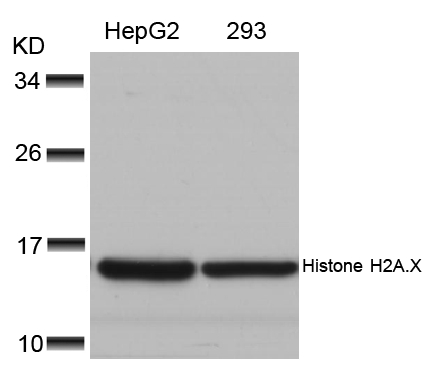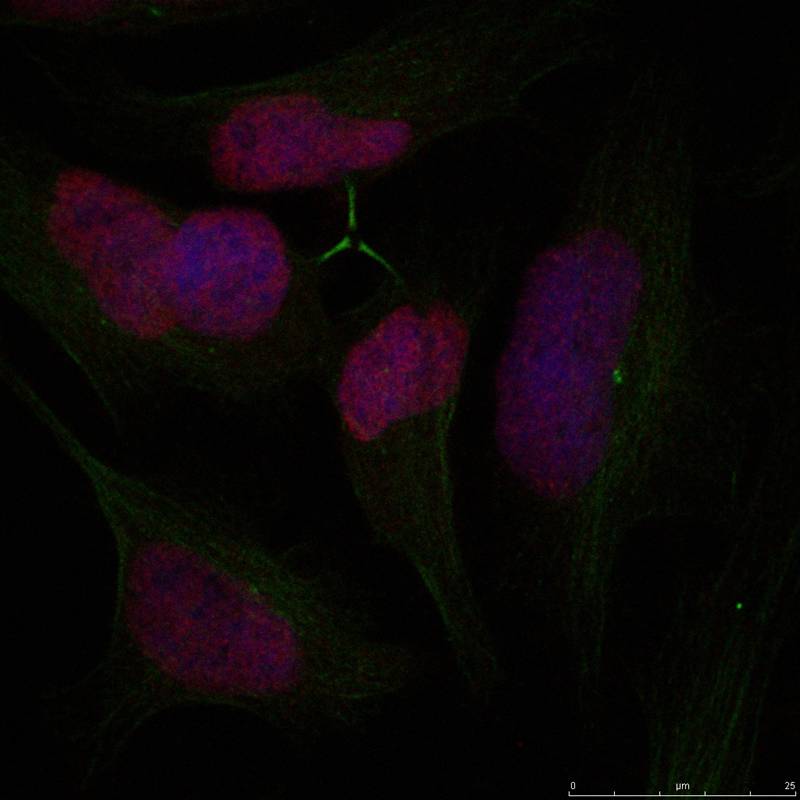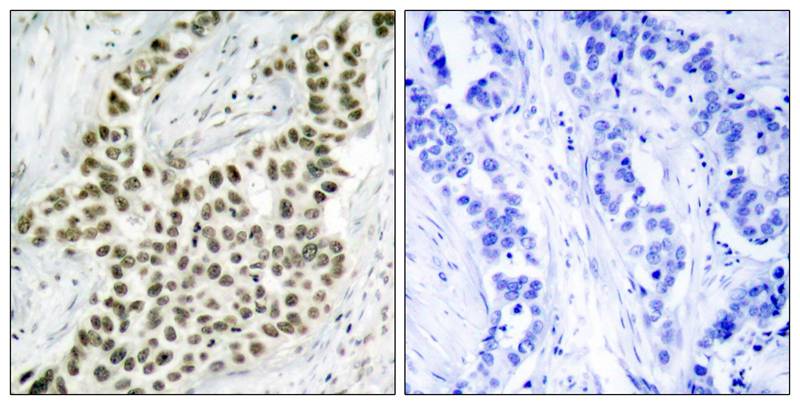


| WB | 咨询技术 | Human,Mouse,Rat |
| IF | 咨询技术 | Human,Mouse,Rat |
| IHC | 1/50-1/100 | Human,Mouse,Rat |
| ICC | 1/100-1/200 | Human,Mouse,Rat |
| FCM | 咨询技术 | Human,Mouse,Rat |
| Elisa | 咨询技术 | Human,Mouse,Rat |
| Aliases | H2A.X; H2AFX; H2a/x; HIST5-2AX; |
| Entrez GeneID | 3014; |
| WB Predicted band size | 15kDa |
| Host/Isotype | Rabbit IgG |
| Antibody Type | Primary antibody |
| Storage | Store at 4°C short term. Aliquot and store at -20°C long term. Avoid freeze/thaw cycles. |
| Species Reactivity | Human |
| Immunogen | Peptide sequence around aa.137~141 (Q-A-S-Q-E) derived from Human Histone H2A.X. |
| Formulation | Purified antibody in PBS with 0.05% sodium azide. |
+ +
以下是关于Histone H2A.X(磷酸化Ser139.即γ-H2A.X)抗体的3篇参考文献,涵盖其在不同研究中的应用及发现:
---
1. **文献名称**: *DNA double-stranded breaks induce histone H2AX phosphorylation on serine 139*
**作者**: Rogakou, E.P., Pilch, D.R., Orr, A.H., Ivanova, V.S., Bonner, W.M.
**摘要**: 该研究首次揭示了DNA双链断裂(DSBs)后,组蛋白H2A.X在Ser139位点的快速磷酸化(γ-H2A.X),并证明其作为DNA损伤标记物的作用。通过免疫荧光和Western blot验证抗体特异性,为后续DNA损伤检测奠定基础。
2. **文献名称**: *GammaH2AX as a marker of DNA double strand breaks and genomic instability*
**作者**: Löbrich, M., Jeggo, P.A.
**摘要**: 本文综述了γ-H2A.X在基因组不稳定性和DNA修复研究中的关键作用,强调了使用特异性抗体(如抗Ser139磷酸化抗体)定位DSBs的技术应用,并探讨了其在癌症与放射生物学中的意义。
3. **文献名称**: *ATM phosphorylates histone H2AX in response to DNA double-strand breaks*
**作者**: Burma, S., Chen, B.P., Murphy, M., Kurimasa, A., Chen, D.J.
**摘要**: 研究证实ATM激酶在电离辐射后介导H2A.X Ser139的磷酸化,通过特异性抗体(如Ab-139)结合免疫沉淀技术,揭示了γ-H2A.X在DNA损伤信号通路中的调控机制。
---
这些文献均使用了针对H2A.X Ser139磷酸化的抗体,验证了其在DNA损伤检测、修复机制及疾病研究中的关键作用。若需具体商业抗体(如Abcam的ab11174或Millipore 05-636),建议查阅供应商提供的引用文献列表。
Histone H2A.X is a variant of the H2A histone family, playing a critical role in maintaining genomic stability and facilitating DNA damage response. The phosphorylation of histone H2A.X at serine 139 (γH2A.X) is a hallmark of DNA double-strand breaks (DSBs), triggered by kinases such as ATM, ATR, or DNA-PK in response to genotoxic stress. This modification forms foci at damage sites, serving as a platform for recruiting repair proteins and signaling molecules. The Histone H2A.X (Ab-139) antibody specifically detects this phosphorylated form (Ser139), making it a vital tool for studying DNA damage and repair mechanisms.
Widely used in techniques like immunofluorescence, Western blotting, and flow cytometry, this antibody helps visualize and quantify γH2A.X foci, enabling researchers to assess DSB induction and repair kinetics in various contexts, including cancer biology, radiation/chemotherapy studies, and aging research. Its specificity and reliability have also made it valuable in evaluating the efficacy of DNA-damaging therapies and exploring genome instability in diseases. Additionally, it serves as a biomarker for assessing cellular responses to environmental toxins or experimental treatments. By targeting a conserved phosphorylation epitope, the Ab-139 antibody ensures cross-reactivity in multiple species, enhancing its utility in translational and preclinical studies.
×